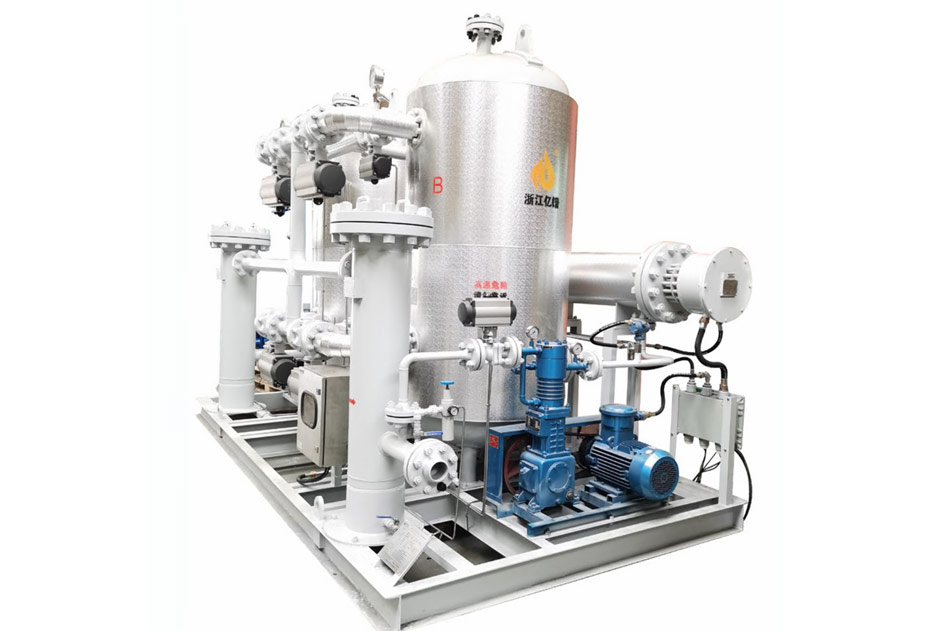Oilfield Wellhead Gas Dehydration Solutions
Industry Pain Points
High Water Content and High Mineralization Degree: The water content of oilfield associated gas exceeds 80%, and it contains highly corrosive ions such as Cl⁻ and Ca²⁺ (mineralization degree up to 50g/L). This causes scaling and clogging in traditional dehydration equipment, shortening maintenance cycles by 60%.
Severe Pressure Fluctuations: Wellhead pressure fluctuates drastically from 0.3MPa (low-pressure gas wells) to 10MPa (high-pressure gas wells), making conventional dehydration systems unable to operate stably.
Interference from Organic Sulfur and Heavy Hydrocarbons: Sulfur-containing compounds (e.g., methyl mercaptan) and C6+ heavy hydrocarbons poison molecular sieves. The service life of imported adsorbents is only 6-12 months, resulting in high replacement costs.
Energy Shortage in Remote Areas: Oilfields are mostly located in deserts/offshore areas with unstable power supply, leading to a 30% failure rate of electrically driven dehydration equipment.
System Overview
Through the “hypergravity separation – pressure energy utilization – sulfur-hydrocarbon synergistic adsorption” technology loop, Yipu Oilfield Wellhead Gas Dehydration System achieves:
- Zero Power Grid Dependence: 100% utilization of on-site energy from wellheads, suitable for extremely remote oilfields.
- Cost Reduction & Efficiency Improvement: Comprehensive costs over 5 years are 65% lower than TEG systems, with an investment payback period of <1.8 years.
- Digital Empowerment: The digital twin system optimizes operating parameters in real time, resulting in a failure rate of <1%.
Solution Approach
Yipu Oilfield Wellhead Gas Dehydration Solution
| Module | Technical Highlights | Performance Parameters |
|---|---|---|
| Mineralized Water Treatment Unit | Ceramic membrane + ultrasonic anti-scaling, anti-scaling capability increased by 10x | Handles mineralization degree ≤100g/L |
| Pressure Adaptive System | Venturi pressure stabilizing valve, adapting to 0.3-12MPa pressure fluctuations | Outlet pressure fluctuation ≤±1% |
| Sulfur-Hydrocarbon Synergistic Adsorption Tower | Layered packing of silica gel and molecular sieves, sulfur/hydrocarbon resistance design | Methyl mercaptan ≤3ppm, dew point ≤-50℃ |
| Off-Grid Energy Package | Solar PV + pressure energy power generation, enabling 100% off-grid operation | Daily power consumption ≤3kWh (for treating 50,000 Nm³ gas) |
| Digital Twin Platform | Real-time simulation of adsorbent saturation, optimizing regeneration cycle | Regeneration energy consumption reduced by 35% |
Applicable Scenarios:
- Onshore/offshore oilfield associated gas treatment
- Instant dehydration at coalbed methane wellheads
- Gas gathering stations in tight gas fields
Technical Principles
Yipu Oilfield Wellhead Gas Four-Stage Dehydration Process:
- Hypergravity Liquid Removal (Stage 1):The vortex acceleration separator generates 500G centrifugal force within 0.1 seconds, removing 95% of free water and solid particles, and adapting to a mineralization degree of ≤80g/L.
- Pressure Energy Refrigeration (Stage 2):Uses wellhead throttling pressure difference to drive the ejector refrigerator, cooling the gas from 50℃ to 8℃ without electricity consumption, and reducing the dew point to -5℃.
- Sulfur-Resistant Adsorption (Stage 3):Silica gel-molecular sieve composite bed:
- Silica gel prioritizes the adsorption of methyl mercaptan (removal rate ≥98%)
- Patented 3A-SH molecular sieves maintain a 5-year service life even at a sulfur content of 2000ppm
- Intelligent Regeneration (Stage 4):Adopts wellhead associated gas self-heating regeneration (150-180℃), saving 80% more energy than electric heating.
Core Advantage
| Advantage | Details |
|---|---|
| Customized on Demand | Meets special working conditions; provides professional non-standard customization |
| Low Cost | Adopts cyclic regeneration process; significantly reduces operating costs |
| High Stability | Dual-tower structure with small pressure fluctuation; low noise and continuous gas supply |
| Fully Automatic Operation | Easy to operate, reducing labor input; improves efficiency |
| High Safety | Presets multi-level safety protection measures; supports automatic alarm |
| Low Failure Rate | Maintains low failure rate after 10,000 hours; high durability with almost no maintenance required |
Technical Strength
Leading Adsorption Dehydration Technology
Uses high-performance molecular sieve adsorbents with high water absorption capacity and resistance to corrosion by acidic gases (H₂S/CO₂), ensuring deep dehydration with a dew point ≤-70℃.
The original hot nitrogen regeneration process reduces energy consumption by 30% compared with traditional electric heating regeneration, and integrates a waste heat recovery system to significantly improve energy efficiency.
Modular and Customized Design Capability
Core equipment adopts modular prefabrication, supporting rapid deployment (installation cycle shortened by 50%) and adapting to diverse scenarios such as offshore platforms, onshore gas fields, and LNG pretreatment.
Can customize single-tower, dual-tower, or multi-tower parallel systems according to customer needs, with a treatment capacity ranging from 10,000 to 1,000,000 Nm³/d, flexibly matching gas fields of different scales.
Intelligent Control and Remote Operation & Maintenance
Equipped with a PLC+IoT intelligent control system, it real-time monitors key parameters such as pressure, temperature, and dew point, supporting fault early warning and automatic adjustment.
Through cloud-based big data analysis, it optimizes the adsorption-regeneration cycle, extends the service life of molecular sieves, and reduces operation and maintenance (O&M) costs by 10%-15%.
Energy-Saving and Environmental Protection Technology
Features zero-emission design for regeneration exhaust gas, complying with international environmental standards such as EU CE and US EPA.
Energy consumption is 25%-40% lower than that of traditional triethylene glycol (TEG) dehydration systems, helping customers achieve carbon emission reduction goals.
Long-Cycle Operation Reliability
Molecular sieves adopt anti-pulverization coating technology, with a service life of over 5 years, reducing replacement frequency.
Key components (e.g., valves, instruments) are selected from international first-tier brands (e.g., Siemens, Emerson), with a Mean Time Between Failures (MTBF) of over 100,000 hours.
Strong R&D and Engineering Experience
Possesses more than 19 patents and software copyrights in dehydration technology; the R&D team is led by doctors and has in-depth cooperation with universities and colleges.
Has over 1,000 successful cases worldwide, covering extreme working conditions such as high-sulfur gas fields in the Middle East and low-temperature environments in the Arctic.
Product Advantage Comparison
| Indicator | Yipu System | TEG Dehydration | Refrigeration Method | Competitor Adsorption Systems |
|---|---|---|---|---|
| Dew Point | -50℃ (customizable to -70℃) | -30℃ | -20℃ | -40℃ (3 replacements per year) |
| Sulfur Resistance | No failure at H₂S ≤3000ppm | Requires pre-installed desulfurization | Not applicable | Poisoning at H₂S ≥500ppm |
| Energy Consumption | 0.01kWh/m³ (off-grid operation) | 0.2kWh/m³ | 0.15kWh/m³ | 0.08kWh/m³ |
| Pressure Adaptability | 0.3-12MPa without adjustment loss | Only applicable for 3-8MPa | Requires stable pressure | Optimal at 1-6MPa |
| Total Investment Cost | Low (no power grid/steam support required) | High (requires boiler + TEG) | Medium (high electricity consumption) | High (imported consumables) |
Typical Case
Project Name: High-Pressure Gas Well Dehydration Station in Tarim Oilfield
Operating Conditions:
- Gas Volume: 80,000 Nm³/day, pressure fluctuating between 5-10MPa
- Water Quality: Mineralization degree 65g/L, H₂S 2500ppm
Dehydration Effect:
- Dew point stably reduced from +45℃ to -55℃
- Molecular sieves have been in operation for 4 years without replacement (imported products require annual replacement)
Economic Benefits:
- Saves 9 million RMB annually in TEG procurement and waste liquid treatment costs
- Achieves annual revenue of 500,000 RMB from pressure energy power generation

